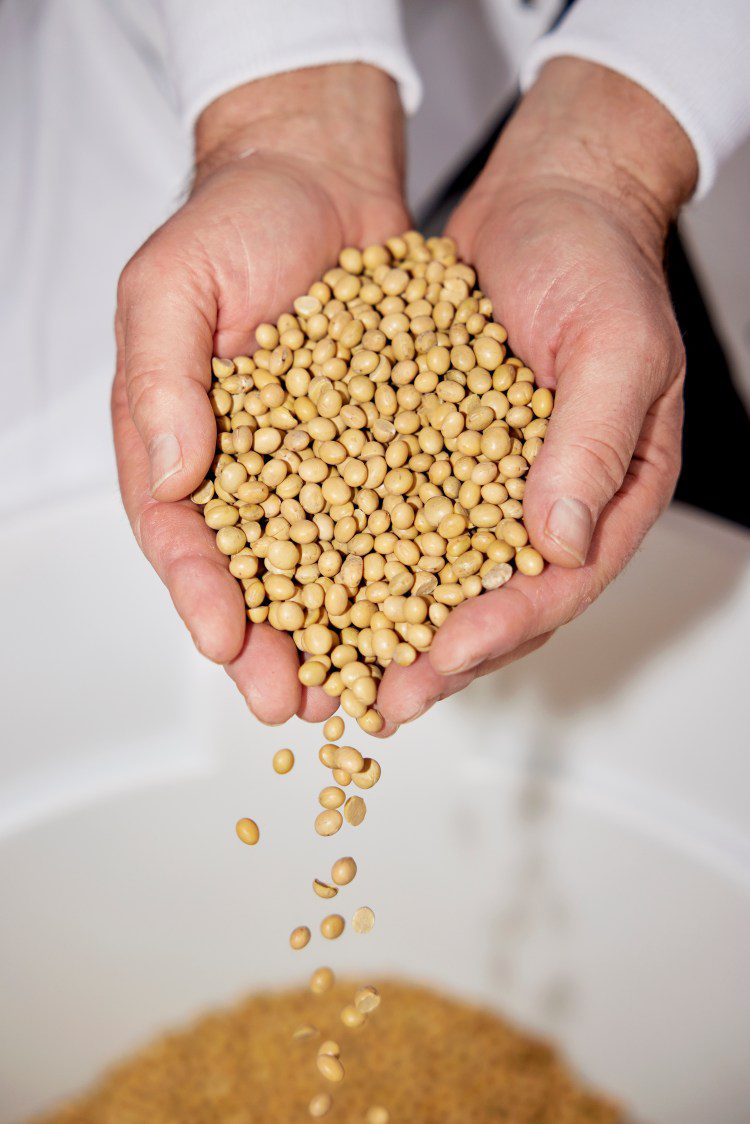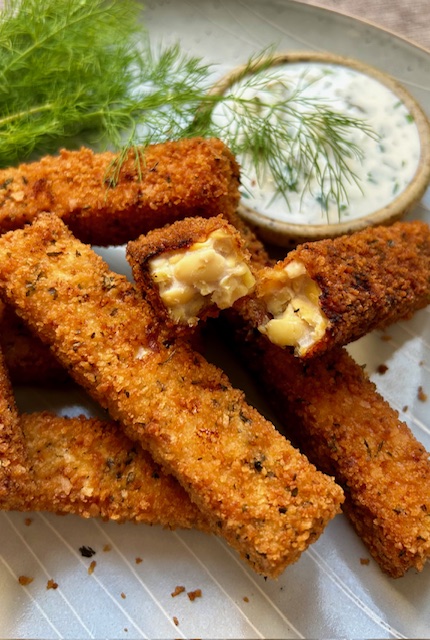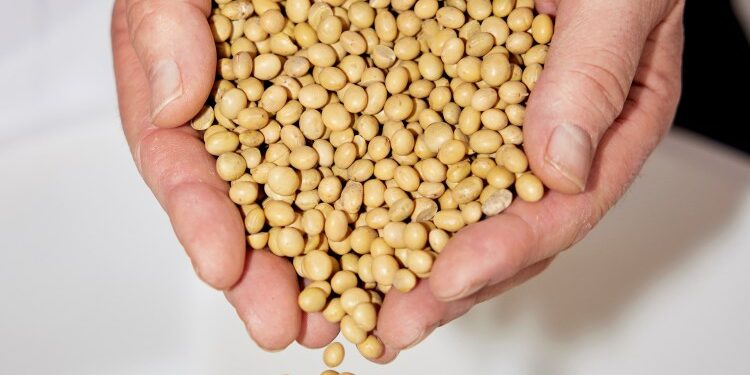

Hulled and split soybeans ready to be turned into tempeh cakes in Biddeford. Photo by Clayton Simoncic
The state faces a growing shortage of organic, locally grown soybeans that can supply its two major soy food producers.
Heiwa Tofu in Rockport buys about 150 tons of organic soybeans a year. Tootie’s Tempeh in Biddeford estimates that by next year it will need 25 tons annually. But the state’s only food-grade processor of Maine-grown, organic soybeans, Aurora Mills & Farm in Linneus, produces only 50 to 75 tons each year. Do the math: That leaves a soybean deficit of more than 100 tons.
The three businesses have banded together in an informal alliance called the Maine Soy Working Group In an effort to increase soybean production. Their goal is to increase the number of farmers cultivating soybeans, a climate-friendly, plant protein.
“I sell out of soybeans every year,” said Aurora Mills farmer Sara Williams Flewelling. She said her limited supply forces Maine buyers to source beans from processors in other New England states, New York and Canada.
Aurora processes its own 100 acres of soybeans by drying, sorting, cleaning and polishing the whole beans. If the farm could recruit other farmers to grow soybeans as well and send them to Aurora for processing, there might be enough to meet the needs of Tootie’s Tempeh and Heiwa, Flewelling said.
The Soy Working Group is in the process of reaching out to local organic potato farmers to see if they have the capacity, and the interest, to expand their crop rotations to include soybeans.
“Last year was an incredibly hard year for grains,” said Flewelling, whose family farm is known for its organic grains. “But because it was wet and hot, it was an excellent year for beans. This year has been hot and the beans in organic production are really tall and ahead of the weeds. A couple of fields are among the best I’ve ever seen. Everything is about two weeks ahead.”
After the soy crop is harvested, in late October or early November, it will be dried, cleaned and milled. The beans will be sold to buyers in the new year.
The ability of soy to withstand some weather conditions that impair grains has helped make her farm more resilient, Flewelling said. She hopes the beans’ hardiness will entice other farmers to give soybeans a try, too. Another selling point: The price of soy is higher than the price of wheat, she said.
Aurora also needs new equipment, specifically a bean splitter, as unlike Heiwa, Tootie’s Tempeh requires split soybeans. Toward that end, Speare plans to apply for a government grant earmarked for food processing equipment in hopes of funding the purchase of a bean splitter for Aurora.
Speare learned about the grants through her participation in the Maine Food Processing Infrastructure Work Group, which formed in 2021 and is coordinated by the Maine Food Convergence and the Maine Farm and Sea to Institution groups.
“Besides strategically thinking about what is needed, these work groups also build relationships throughout time,” said Annie Doran, project coordinator of the Maine Food Convergence, which recently helped secure a $1.4 million grant with Full Plates, Full Potential to create a Food Supply Switch Board to connect excess Maine food with farms and factories that can process it. “Partnerships are much more effective if we already have relationships.”
Before they learned the process wasn’t allowed at their location, Tootie’s had planned to mill its own beans. Instead, the company has been buying split, de-hulled beans in Quebec, Speare said.
When Heiwa, the state’s only tofu maker, was founded 16 years ago, it used just 12 tons of soybeans a year. Its production has increased more than tenfold since then, pushing the company to the limits of it current space. It hopes to break ground next spring on an expansion of its Rockport facility.
“As we’ve grown, we have less ability to handle soybeans that are less than perfect,” said Heiwa owner Jeff Wolovitz, who last year began supplying the Whole Foods stores in New York and New Jersey. “If we get (a shipment of beans) that has stones in it, it breaks the equipment, slows us down and we can’t fill orders. As we’ve gotten busier, we have less ability to absorb those inefficiencies. The right (post-harvest) processing equipment is critical and expensive.”
Speare said that Tootie’s would like to replicate its tempeh production in other locations around the country, where it would also seek to source local soybeans.
“Because Maine has tofu and tempeh makers, there’s a huge opportunity to increase soybean production,” Speare said. “We’re just starting to get traction and awareness.”


Tootie’s Tempeh Fish Sticks. Photo by Kate Musser
Tempeh “Fish” Sticks
Developed by chef and Tootie’s Tempeh operations manager Kate Musser, this recipe is packed with plant protein from soybeans, whose consumption is linked to better health.
Marinade:
1 cup vegetable stock
2 tablespoons apple cider vinegar or rice vinegar
1 tablespoon miso
1 tablespoon mirin
1 tablespoon nutritional yeast
1 ½ teaspoons tamari
1 sheet nori, finely chopped
Salt and pepper, to taste
2 (8-ounce) packages Tootie’s Tempeh
Tartar Sauce:
1 cup vegan mayo (homemade or store-bought)
1 cup finely chopped dill pickles
2 tablespoons chopped fresh dill
2 teaspoons fresh lemon juice
Breading:
Flour
Non-dairy milk
Panko bread crumbs (seasoned is best)
Oil for frying
Combine the marinade ingredients, except for the tempeh, and whisk them together in a small bowl.
Place the whole tempeh cakes in a Ziplock bag or a bowl and pour the marinade over. Close/cover and let the tempeh marinate for at least 3 hours. Overnight is best.
Make the tartar sauce by combining all ingredients in a bowl and stirring until combined.
When you are ready to eat, bread the tempeh. After the tempeh has marinated, remove it from the bag/bowl and cut it into 1-inch strips. Dredge each piece of tempeh first in flour, then dip it in milk, then coat it in panko.
You can air fry the tempeh or you can pan fry. If you are pan frying: In a small pot over medium heat, add about 1 cup of oil and bring it up to 350-375 degrees F. Fry the tempeh in small batches for about 5 minutes on each side or until they are golden brown. Place the tempeh sticks on a cooling rack so that excess oil can drip off and they can slightly cool.
Avery Yale Kamila is a food writer who lives in Portland. She can be reached at [email protected].
Copy the Story Link
Source link : http://www.bing.com/news/apiclick.aspx?ref=FexRss&aid=&tid=66d452758090468284f8f07ac303921d&url=https%3A%2F%2Fwww.centralmaine.com%2F2024%2F09%2F01%2Fnote-to-maine-farmers-more-soybeans-please%2F&c=1998772436858168052&mkt=en-us
Author :
Publish date : 2024-08-31 21:01:00
Copyright for syndicated content belongs to the linked Source.




